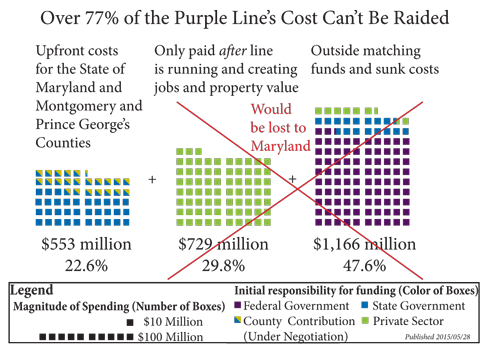
Governor Larry Hogan says Maryland can’t afford the Purple Line. But as this chart shows, canceling the line would throw away billions of dollars, and save only a few million.
The chart illustrates where the money to build the Purple Line comes from. Purple boxes correspond to federal funding, green boxes are the private sector, and yellow boxes are from Montgomery and Prince George’s counties. The blue boxes are the only money coming from the State of Maryland.
There are a total of 245.5 boxes on the chart, representing the Purple Line’s total cost of $2.45 billion. Out of those 245.5 boxes, only 74 are state-funded blue. And out of those 74 blue boxes, 16 of them are in the far-right column, indicating money that’s already spent. Another 22 boxes are half yellow, representing the requested county contribution. That leaves only 33 boxes, representing $333 million in remaining funding that is solely the state’s responsibility.
In other words, Governor Hogan is holding Purple Line hostage over 13% of its cost.
And it may be even less than that. If Transportation Secretary Rahn’s proposal to cut costs by 10% can become a reality, that would eliminate 23 of the remaining 33 blue state boxes, leaving only 10.
If that happens, Maryland’s state cost to build the Purple Line could drop to as low as $100 million.
This is why cancelling a project would be a radical move. It would sacrifice billions of dollars in investment as well as spite both local opinion and the business community just to scavenge less than 23% of its total value.
More detail
This graphic breakdown comes from two primary sources: the Federal Transit Administration’s November 2014 Profile and the
Maryland Transit Administration’s (MTA) Capital Program Summary.
The leftmost column shows the upfront costs to the state and counties. This is money that could theoretically go to other state or county transportation projects.
The second column covers the non-transferable TIFIA loan that a private-sector partner is undertaking with federal assistance. Maryland doesn’t get the benefit of this money unless it goes toward the Purple Line.
The last column shows other money Governor Hogan would be walking away from if he cancels the line. That includes a $900 million grant from the federal government, $81 million from the private partner, and $184.7 million already spent in planning and design. It doesn’t include the billions in new economic activity that the line would spur. None of this money is transferable to other Maryland project.
In addition, the sunk costs include $26.6 that the federal government has already spent on the Purple Line. The state may be liable for that if Hogan cancels the line.
